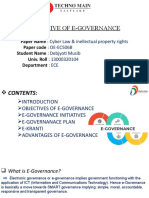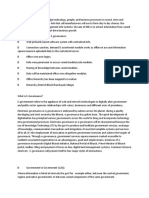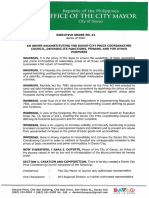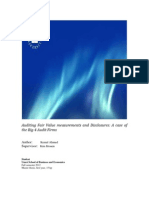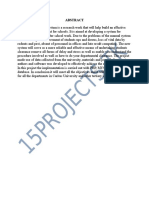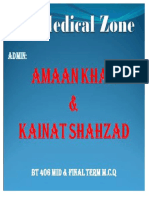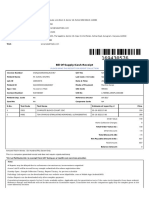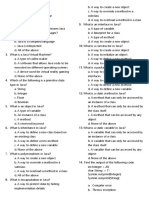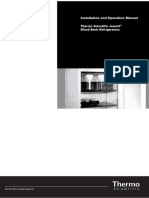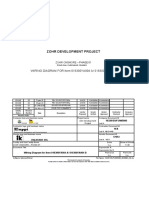Governance
Lecture 05: E-Governance and Accountability
Examples of Efficiency in Governance:
● Reduction of Leakages under the Public distribution system
● Direct Benefit Transfer
● Right to Information Act
● E-portals
What is E-Governance?
● Use of Technologies or use of information technology by governments to transform
relationship with citizens (Business and other governments).
E- Governance is about bringing SMART Governance viz:
● S - Simple:Simplification of rules and proceduresof Government making it user friendly.
(UPI)
● M-Moral:Infusion of ethics and values into governance,ensuring integrity and
accountability among officials. Enhancedanti-corruptionmeasuresandvigilance agencies
improve moral standards in administrative systems.
● A- Accountable:ICT helps set standards of performanceand efficiently measures it.
● R- Responsive:Efficient service delivery and governmentthat is in tune with the people. •
(PRAGATI, E-AADHAR).
● T - Transparent:Information confined to secrecy isout in the public domain bringing
equity and rule of law in public agencies.
PW Web/App:https://smart.link/7wwosivoicd4
� Models of Governance:
Models Services/Information Shared Initiatives/Examples
Government to ● Payment of online bills such as ● Computerisation of Land Records
Citizen (G2C) electricity, water, telephone bills ● Bhoomi Project in Karnataka
etc. aimed at digitizing land records
● Online registration of applications ● Digital Locker System etc.
● Online copies of land-record ● Gyaandoot in Madhya pradesh
● Online filling of complaints (Intranet based service delivery,
● Availability of any kind of online Interface between District
information etc administration and citizens
● LOKVANI project in Uttar pradesh
(Land records and Grievance
redressal)
● My.Gov Portal
● Project FRIENDS in Kerala aimed
at providing multiple public
services through a single window
system.
Government to ● Government document exchange ● Khajane Project in Karnataka
Government (G2G) ● Finance and budget management aimed at streamlining and
etc. automating the state's treasury
operations.
Government to ● Tax collection ● e-Procurement Project in Andhra
Business (G2B) ● Patent approvals and rejections Pradesh and Gujarat
● Bill and penalty payments ● SWIFT (Single Window Interface
● Information and rule sharing etc. for Facilitating Trade) initiative
to streamline and simplify
international trade processes. etc
Government to ● Data submissions (attendance, ● Mission Karmayogi/ Integrated
Employees (G2E) employee records) Government Online TrainingiGOT
● Complaint filing Karmayogi platform etc.
● Sharing rules and regulations ● PRAGATI
PW Web/App:https://smart.link/7wwosivoicd4
� ● Payment and work records etc. ● GATI SHAKTI
Initiatives of E-governance in India:
National e-Governance Action Plan (NeGP)
● Subsumed under theDigital Indiaprogram.
● Aims to enhance online government services and make governance more accessible and
efficient.
● Key components:
○ State Data Centers (SDCs): Provide centralized infrastructurefor hosting
e-governance applications.
○ Common Service Centers (CSCs): Facilitate deliveryof government services to
rural and remote areas.
○ State e-Governance Service Delivery Gateways (SSDGs):Enable seamless service
delivery across government departments.
○ e-Districts: Implement district-level e-Governanceservices, improving efficiency
and transparency at the local level.
○ Capacity Building: Training and skill developmentfor government personnel to
improve e-Governance implementation.
Initiatives of E-governance in India by Central government
Aadhaar:
● A unique 12-digit identification number issued by the Government of India, based on
biometric and demographic data.
● Used for identification purposes in various government services and welfare schemes.
UMANG Portal:
● Unified Mobile Application for New-age Governance (UMANG) provides access to various
government services on a mobile platform.
● Facilitates services related to health, education, taxation, and welfare. (For ex: PAN cards)
PW Web/App:https://smart.link/7wwosivoicd4
�Digi Locker:
● A digital locker system that allows citizens to store and share documents online securely.
● Provides access to a variety of documents such as academic certificates, driving licenses,
and PAN cards.
PRAGATI:
● Pro-Active Governance And Timely Implementation (PRAGATI) is a platform for addressing
public grievances and monitoring the progress of major government projects.
● Combines audio-video-conferencing for resolving issues related to projects, grievances, and
implementation.
Mobile Sewa:
● A mobile-based application that facilitates citizens' access to government services through
smartphones.
● Provides real-time information on government services and schemes, and allows citizens to
make online requests.
Digi Sewaks:
● A digital volunteer program that engages people to assist citizens in using digital
government services.
● Helps bridge the digital divide by providing guidance on using e-governance tools.
India Stack:
● A set of application programming interfaces (APIs) that enable governments, businesses,
and developers to offer paperless and cashless services.
● Includes Aadhaar, UPI, eKYC, DigiLocker, and other services for secure and seamless service
delivery.
PW Web/App:https://smart.link/7wwosivoicd4
�Direct Benefit Transfer (DBT):
● A system that directly transfers subsidies, grants, and benefits to the bank accounts of
eligible beneficiaries, ensuring faster and transparent delivery of government schemes.
● Helps reduce corruption and delays in welfare schemes.
● No middlemen and quick resolution
JAM Trinity:
● JAMstands forJandhan (Bank Accounts), Aadhaar, and Mobile.
● It is a framework aimed at ensuring direct benefits reach citizens, promoting financial
inclusion, and reducing leakage and fraud in government welfare schemes.
● Provides a platform for direct cash transfers and financial services for the marginalized
sections of society.
Challenges of E-Governance in India:
● There are a large number of obstacles in implementation of e-Governance in India. These
can be categorized under the following:
Technological Challenges
● Digital Infrastructure:
○ Limited Broadband Connectivity:Many rural and remoteareas still lack
high-speed internet access, making it difficult to provide consistent e-governance
services across the country.
○ Power Supply Issues:Frequent power outages and unreliableelectricity supply in
rural areas can disrupt the functionality of digital infrastructure.
● Interoperability:
○ Fragmented Systems:Different government departmentsuse various legacy
systems that are not always compatible with each other. This lack of
standardization hinders seamless data sharing and coordination among agencies.
○ Integration with Legacy Systems:Upgrading and integratingold systems with
new technologies is complex and costly.
● Data Security and Privacy:•
PW Web/App:https://smart.link/7wwosivoicd4
� ○ Cybersecurity Threats: With increasing digitization, the risk of cyberattacks and
data breaches has also increased. Ensuring robust cybersecurity measures is
essential to protect sensitive government and citizen data.
○ Data Privacy Concerns:There are significant concernsregarding the protection of
personal data, especially in the absence of a comprehensive data protection law.
User Accessibility and Inclusivity:
○ Language Barriers:India is a diverse country with multiple languages. Ensuring that
e- governance services are accessible in all major languages is necessary for
inclusivity. •
○ Accessibility for Differently-Abled:Ensuring thatdigital services are accessible
to differently-abled individuals requires additional technical considerations and
implementations
Economic Cost:
● High Implementation Costs:The initial cost of settingup digital infrastructure,
maintaining systems, and training personnel is substantial. Securing sustained funding for
these activities is often challenging.
● Cost of Advanced Technologies:Implementing cutting-edgetechnologies such as AI and
blockchain can be prohibitively expensive for widespread deployment.
Administration:
● Acceptance:Both citizens and government employeesmay resist the shift to digital
platforms due to a lack of familiarity or comfort with technology.
● Lack of willingness:Traditional methods of governanceand public service delivery are
deeply entrenched, making the transition to e-governance slow.
Way Forward:
Recommendations of 2nd ARC on e-governance
● Business Process Re-engineering:Governmental forms,processes and structures should be
re-designed to make them adaptable to e-Governance, backed by procedural, institutional
and legal change.
PW Web/App:https://smart.link/7wwosivoicd4
� ● Capacity Building and Creating Awareness: Capacity building efforts must attend to both
the organizational capacity building as also the professional and skills up gradation of
individuals associated with the implementation of e-Governance projects. (For ex: IGOT,
Mission Karmayogi).
● Legal Framework for e-Governance:A clear road mapwith a set of milestones should be
outlined by the Government of India.
● The Common Support Infrastructure:The State Data Centres (SDCs) should be
maintained by Government agencies such as NIC as it involves handling of sovereign data.
Further, all data centres at the State level should be subsumed in the SDCs.
● Knowledge Management: Union and State Governmentsshould take proactive measures for
establishing Knowledge Management systems as a pivotal step for administrative reforms in
general and e-Governance in particular.
● Developing Technological Solutions:Develop a nationale-Governance ‘enterprise
architecture’ framework as has been done in some countries.
● Developing political will and pushing reforms in an administrative structure
● Building a Congenial Environment:Building a congenialenvironment is a sine-qua-non for
successful implementation of e-Governance initiatives. This should be achieved by:
○ Creating and displaying a will to change within the government
○ Providing political support at the highest level of Incentivising e-Governance
○ Creating awareness in the public with a view to generating a demand for change.
● Developing Digital Infrastructure
● Public-Private Partnership (PPP):Several componentsof e-Governance projects lend
themselves to the Public-Private Partnership (PPP) mode through a transparent process.
● Incentivise adoption of E - governance and increase budgetary allocation
● Evaluation of success and failure in the government projects
Social:
● Increasing Digital literacy
● Community based approach to increase awareness
● Document best practices and create public awareness to enhance trust and belief
PW Web/App:https://smart.link/7wwosivoicd4
�Recent concerns around E-governance:
● Digital Divide:
○ Urban-Rural Gap:A significant disparity exists betweenurban and rural areas in
terms of access to digital technology, internet connectivity, and digital literacy.
While urban areas have better access to the internet and technology, rural areas
often lack reliable infrastructure, which hampers the implementation of
e-governance initiatives.
○ Socio-Economic Divide:Lower-income groups and marginalized communities often
face difficulties accessing digital services due to limited resources, devices, and
awareness.
● Jan dhan accounts:
○ Inactive Accounts:Although over 46 crore Jan Dhanaccounts have been opened as
of recent reports, many of them remain inactive due to insufficient deposits or lack
of access to other banking services.
○ Limited Financial Literacy:Many account holders lackawareness of how to use
digital banking services, limiting the effectiveness of Jan Dhan accounts in terms
of financial inclusion.
Internet shutdowns:
● Internet shutdowns disrupt access to digital government services, hindering the delivery of
essential services like health, education, banking, and emergency information.
● Shutdowns have adverse effects on businesses, education (especially during the COVID-19
pandemic), and the functioning of government platforms like Aadhaar, e-governance
portals, and online applications.
PW Web/App:https://smart.link/7wwosivoicd4
































